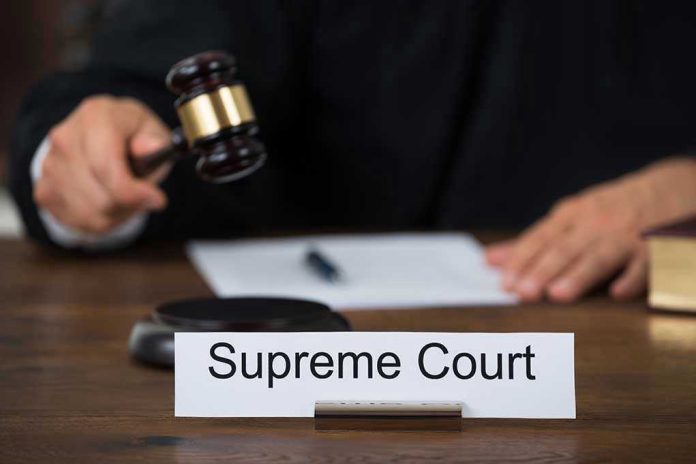
The Supreme Court is poised to decide whether Louisiana’s attempt to comply with the Voting Rights Act by creating a second majority-Black congressional district violates the Constitution—a ruling that could dismantle decades of protections against racial vote dilution and reshape American elections for generations.
Story Snapshot
- Supreme Court heard rearguments on October 15, 2025, in Louisiana v. Callais, questioning whether Louisiana’s two majority-Black districts constitute unconstitutional racial gerrymandering
- The case directly impacts the 2026 midterm elections and could redefine how states balance Voting Rights Act compliance with Equal Protection Clause requirements
- Louisiana redrew its congressional map in 2024 after federal courts ruled the original single majority-Black district likely violated the VRA by diluting minority voting power
- A ruling against Louisiana could weaken the Voting Rights Act nationwide and eliminate remedies for racial discrimination in redistricting across states with significant minority populations
Constitutional Clash Over Race-Conscious Redistricting
Louisiana’s 2024 congressional map creates two majority-Black districts, covering approximately one-third of the state’s population that identifies as Black. Federal courts initially determined that Louisiana’s 2022 map, which contained only one majority-Black district, likely violated Section 2 of the Voting Rights Act by preventing Black voters from electing candidates of their choice. The state legislature responded by passing Senate Bill 8, establishing a second majority-Black district to remedy the violation. However, opponents now argue that intentionally drawing districts based on race—even to comply with federal civil rights law—violates the Equal Protection Clause of the Fourteenth Amendment, creating a fundamental tension between two constitutional principles.
The Supreme Court’s decision to order reargument in June 2025, focusing specifically on constitutional questions surrounding race-conscious districting, signals the case’s extraordinary significance. This procedural move is rare and indicates deep divisions among the justices about how to reconcile federal voting rights protections with constitutional prohibitions against racial classifications. The Court scheduled supplemental briefing and reargument for October 15, 2025, directing parties to address whether states can intentionally create majority-minority districts as a remedy for Voting Rights Act violations without running afoul of constitutional equal protection guarantees.
Stakes for Federal Voting Rights Protections
The outcome in Louisiana v. Callais will determine whether the Voting Rights Act remains an effective tool against racial discrimination in elections or becomes largely unenforceable. Civil rights advocates, including the NAACP Legal Defense Fund, warn that ruling against Louisiana would create an impossible standard: states could be found to violate the VRA for failing to create majority-minority districts, yet simultaneously be prohibited from remedying those violations by drawing such districts. This legal catch-22 would effectively nullify Section 2 of the Voting Rights Act, which was designed specifically to prevent voting practices that dilute minority electoral power.
Louisiana’s history of racial discrimination in voting provides crucial context for understanding why federal courts initially ordered the remedial map. The state has systematically limited Black political representation through various mechanisms over decades, making federal oversight necessary to ensure fair elections. The 2022 map confined Black voters—who comprise roughly one-third of Louisiana’s population—to a single congressional district out of six, despite clear evidence that a second district could be drawn while maintaining traditional redistricting principles like compactness and respect for political boundaries. Federal courts found this configuration likely violated the VRA by fragmenting Black voting strength across multiple districts where they lacked the ability to elect their preferred candidates.
Implications for 2026 Midterms and Beyond
The timing of this Supreme Court decision carries immediate consequences for the 2026 midterm elections, where control of the U.S. House of Representatives may hinge on just a few seats. Louisiana’s congressional delegation currently reflects the two-district map, but a ruling invalidating this configuration could force another redistricting cycle before the next election. This uncertainty creates chaos for candidates, voters, and election administrators who need stable district boundaries to prepare for campaigns and conduct elections fairly. The broader political impact extends beyond Louisiana, as similar redistricting disputes are pending in other states with substantial minority populations, including Alabama, Georgia, and Texas.
The case represents a critical test of whether constitutional principles of colorblind equal protection can coexist with remedial measures designed to address documented racial discrimination. Some legal scholars argue that prohibiting race-conscious remedies for proven racial discrimination creates an absurd result: acknowledging discrimination exists while simultaneously forbidding any effective solution. Others contend that any consideration of race in government decision-making, regardless of intent, violates fundamental equal protection principles. The Supreme Court’s resolution of this tension will establish precedent affecting redistricting, voting rights enforcement, and potentially other areas where remedial racial considerations intersect with constitutional equality guarantees for decades to come.
Sources:
Louisiana v. Callais – NAACP Legal Defense Fund

















